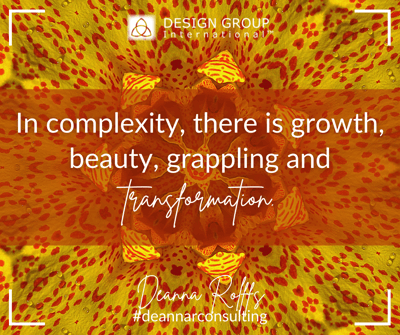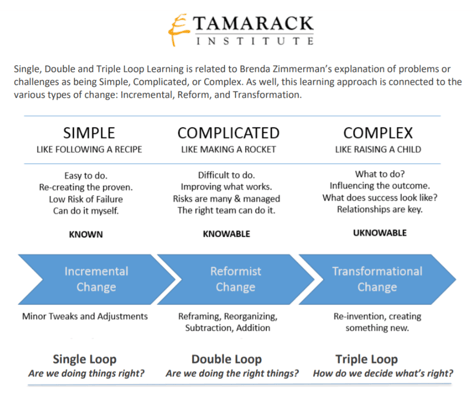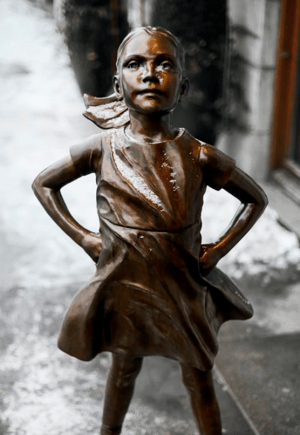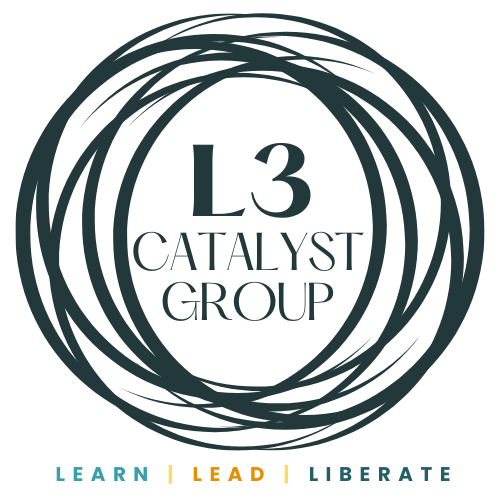 Did your organization write a public statement about diversity, equity, and inclusion last year after George Floyd’s murder? Did you join a march for racial justice? How have you breathed life into that statement since last summer?
Did your organization write a public statement about diversity, equity, and inclusion last year after George Floyd’s murder? Did you join a march for racial justice? How have you breathed life into that statement since last summer?
For a few months, I’ve been thinking about applying anti-oppression commitments (specifically racial equity and justice) to triple loop learning. In the United States context we love dualism: right/wrong, yes/no, bad/good, evil/pure. We miss so much complexity when we think dualism is the answer.
In complexity, there is growth, beauty, grappling, and transformation.

Complex problems are often not solved in a direct, linear way. Complexity is different from complicatedness, as this graphic illustrates.
 Source: Tamarack Institute: TOOL | Single, Double and Triple Loop Learning
Source: Tamarack Institute: TOOL | Single, Double and Triple Loop Learning
What examples from your life are aligned to these three columns?
I recently learned about triple loop learning, as defined here:
Single Loop Learning: making adjustments to correct a mistake or a problem. It is focused on doing things right. Causality might be observed but typically is not addressed.
Double Loop Learning: identifying and understanding causality and then taking action to fix the problem. It is about doing the right things.
 Triple Loop Learning goes even deeper: exploring our values and the reasons why we even have our systems, processes, and desired results in the first place. It is about trying to ascertain an understanding of how we make decisions that frame our work.
Triple Loop Learning goes even deeper: exploring our values and the reasons why we even have our systems, processes, and desired results in the first place. It is about trying to ascertain an understanding of how we make decisions that frame our work.
Source: Tamarack Community
I’ve been curious about how applying triple loop learning to anti-oppression commitments. How does it affect outcomes, particularly in racial equity and inclusion commitments? Most sources that apply triple loop learning to Diversity, Equity, and Inclusion focus on diversity management in Human Resources. My focus is not on just diversity; I want to focus on inclusion, belonging, and equity every day, not just in hiring practices. If the board or workplace isn’t inclusive, the presence of difference will expect those with marginalized identities to conform or be tokenized for their difference.
Reflecting back upon my experience with the most efficacious leaders and teams, I notice that when leaders embrace double and triple loop learning, they lead bravely, grow thriving teams, and are more able to disrupt inequity.
Applying these three learning methods to equity and inclusion, looks something like this:
| Loop | Single Loop Learning | Double Loop Learning | Triple Loop Learning |
| Complexity Source: Glouberman & Zimmerman |
Simple | Complicated | Complex |
| Example | “Do diversity” work | Acknowledge power dynamics | Dismantle oppression |
| Definition Source: Tamarack Community |
Single Loop Learning is about making adjustments to correct a mistake or a problem. It is focused on doing the things right. Causality might be observed but typically is not addressed. | Double Loop Learning is identifying and understanding causality and then taking action to fix the problem. It is about doing the right things. |
Triple Loop Learning goes even deeper to explore our values and the reasons why we even have our systems, processes and desired results in the first place. It is about trying to ascertain an understanding of how we make decisions that frame our work. |
| People ask: | Are we doing things right? What is the answer? |
Are we doing the right things? Is there a better way? |
How do we decide what is right? What is whiteness and how does it affect us? |
| Timeline | Timeline is short | Moderate | Long term, generations-long |
| Looks and Sounds Like (examples, not exhaustive list) |
● “Doing” diversity as a task to accomplish in a training ● Offer an implicit bias training ● Increase racial-ethnic (or other) difference diversity ● Try to train away racism or other isms ● Basic Affinity or Employee Resource ● Groups - get together to share marginalized experience ● Dualism – right wrong, yes no |
● Unpack power dynamics ● Revise policies and practices to be inclusive ● Inclusion focused ● Unearth real experiences of BIPoC/most marginalized ● Listen, shift, learn, apply ● CQI Continuous improvement ● Apply design thinking ● Affinity groups with influence and power via voice and choice ● Apply intersectionality ● Some comfort with learner vs. expert stance |
● Ground the work in dismantling systems of oppression ● Unpack how your organization has benefited from historical and current oppression: racism, white supremacy, anti-LGBTQ sentiment/belief/practices, sexism, etc. ● Face the ways we exclude, expect "others" to confirm to "our" norm ● Build spaces of true belonging ● Ask hard questions. Embrace lack of linearity. ● Don't know exactly what change you seek...yet ● Leaders are engaged, informed, ask hard questions, don’t give pat answers, seek complexity ● Apply liberatory design thinking ● Unpack white supremacy culture’s characteristics and apply antidotes ● Eschewing dualism and embracing complexity |
| Mindsets, Behaviors, Evidence (examples, not exhaustive list) |
● Defensiveness ● Attempt to explain away or distance from the oppression (I’m one of “the good ones”) ● Soften language to appease power (“how will people feel if we say that word?”) ● Focus on safety (“this has to be a safe space” which protects the dominant identities) ● One and done (“I’ve been to a diversity training before, so do I have to attend this?”) |
● Evidence of some psychological safety ● Initial awareness of systems of oppression ● Focus on bravery (instead of safety) ● Personal reflection on how one perpetuates or benefits from the oppression and lack of belonging ● Relational trust is present ● Asking “what will we risk” |
● Rooted in deep relational trust ● Embrace accountability toward personal disruption of inequity, always working to disrupt the internalized -ism (dominant group) or internalized oppression (othered group) ● Centers those with marginalized identities (decentering whiteness, maleness, straightness, etc.) ● Flips power dynamics ● Motivated by goal of liberation |
Single, double, and triple loop learning is evidenced every day with leaders and teams working to transform for a vibrant future, as a recent case study illustrates:
An arts organization's CEO knew that traditional diversity strategies wouldn't facilitate inclusiveness. Although many board members expected technical (vs. adaptive), diversity-focused solutions.
The CEO knew that a traditional, recruitment diversity strategy would likely result in the subsequent exit of the recruited board members of color, due to dominant narratives, ways of working, assumptions, mindsets, and historical racism found in the arts sector. Double and triple loop learning and commitments were required for the change that they sought.
Their executive leaders and steering committee members worked for months to learn, grapple, and increase their consciousness to thoughtfully create a framework that defines why they are working for equity and inclusion, and how their sector has been complicit and benefited from racial, gender, and other oppression. They defined their commitments rooted in relationships, worked to take a learner, not expert, stance, and embedded action and accountability to apply their new commitments. At the outset, they didn't know how the process would change them, personally and professionally. It solidified their commitment to more fully live out their mission. The process wasn't linear, yet they worked toward transformation and thriving. As they finish their framework, they are brave, committed, and positioned well to learn about their learning, embrace complexity, and flip power dynamics. This is double and triple-loop learning at work, transforming organizations and people.
Where do you see your personal commitments evidenced in these learning loops?
Where would you place your organization?
What is missing in drafty-draft grid?
 Applying triple loop learning helps us dismantle oppression. Anti-oppression commitments are the responsibility of all organizational leaders from the CEO and VPs to Directors and Managers.
Applying triple loop learning helps us dismantle oppression. Anti-oppression commitments are the responsibility of all organizational leaders from the CEO and VPs to Directors and Managers.
Fellow leaders and learners, I wish you courage and resilience for the journey.
Peace to you,


What I’m Reading & Watching
Regarding This Topic:
- Triple Loop Learning – Education Technology - Brett Salakas
- Triple Loop Diversity & Inclusion – Bartholomew Jae
- Managing Diversity Through Triple-Loop Learning: A Call for Paradigm Shift

Questions for Consideration
Regarding This Topic:
- How are triple loop learning components evident in your mindsets, your relationship interactions?
- Do you see evidence of triple loop learning in your organization or systems in which you engage?
- What steps can you take to build support and accountability toward triple loop learning complexity?
- When have you learned about your learning and what was the impact of that on your mindsets?

Catch-up on Previous
Leadership & Learning Topics:
Tags:
Miseducation, diversity, triple loop learning, anti-white supremacy, White Supremacy Culture, anti-racism, leadership development, equity, inclusion, anti-oppression, definitions
June 30, 2021




Comments